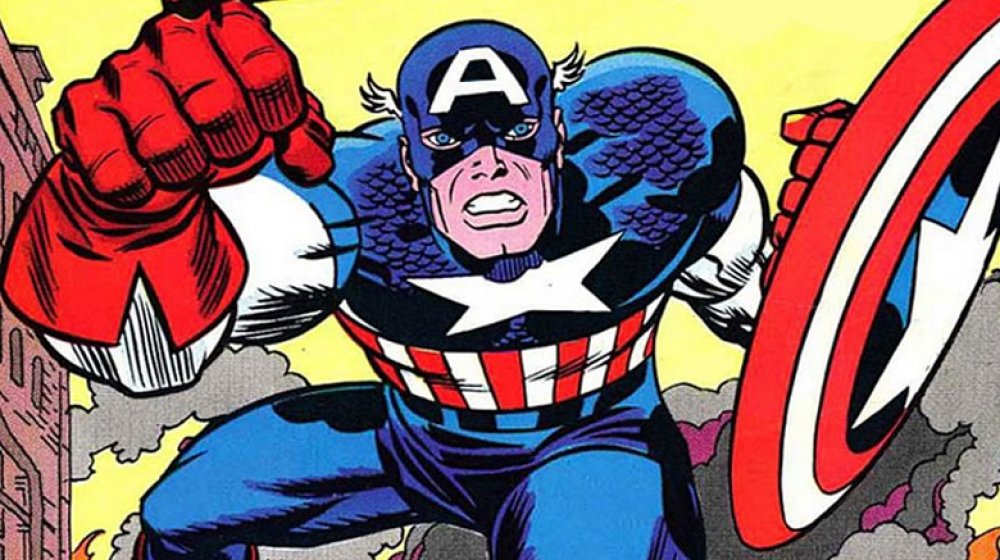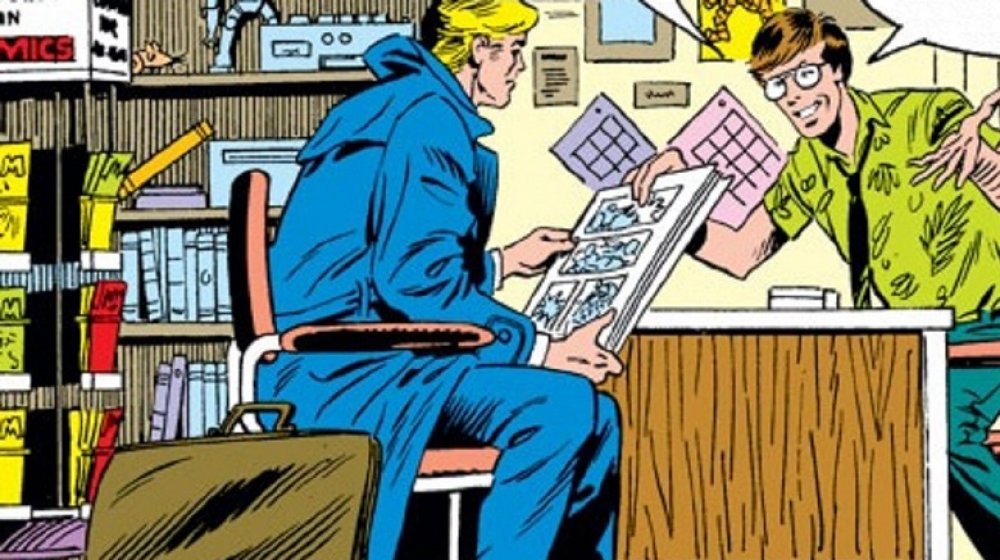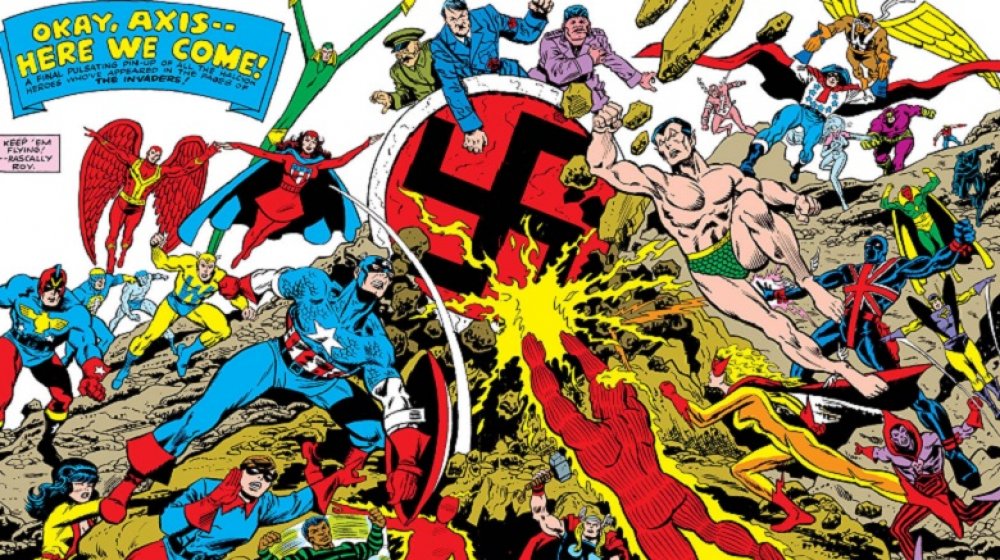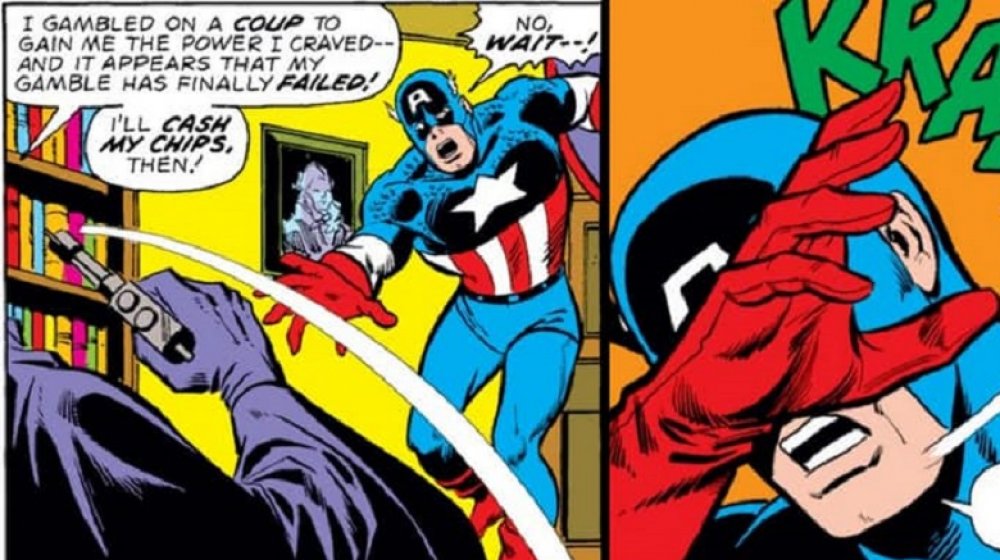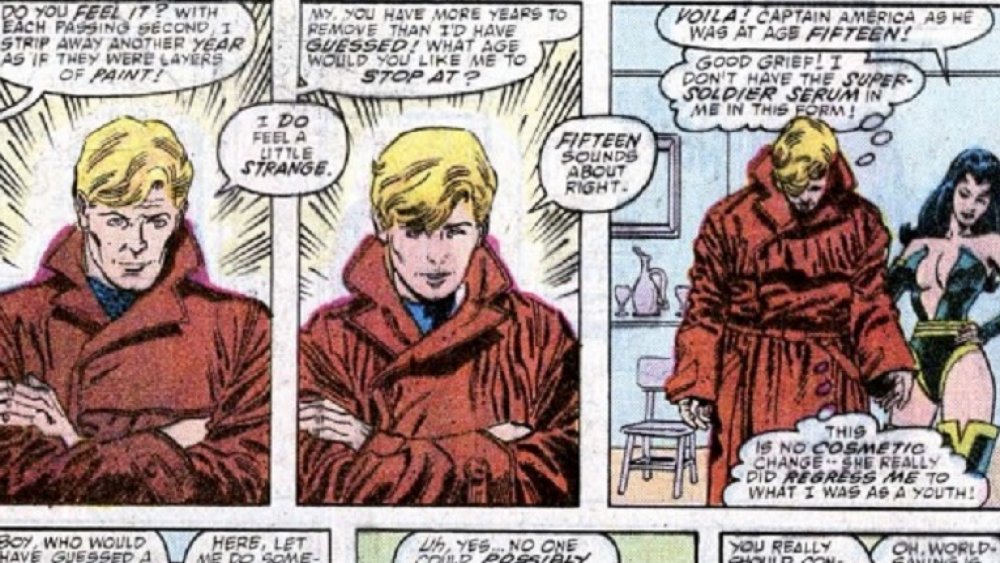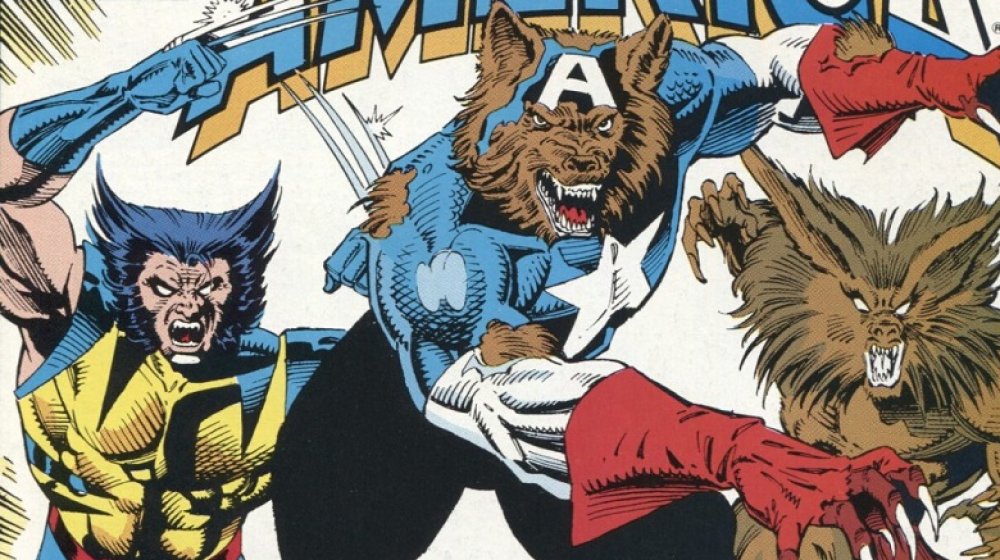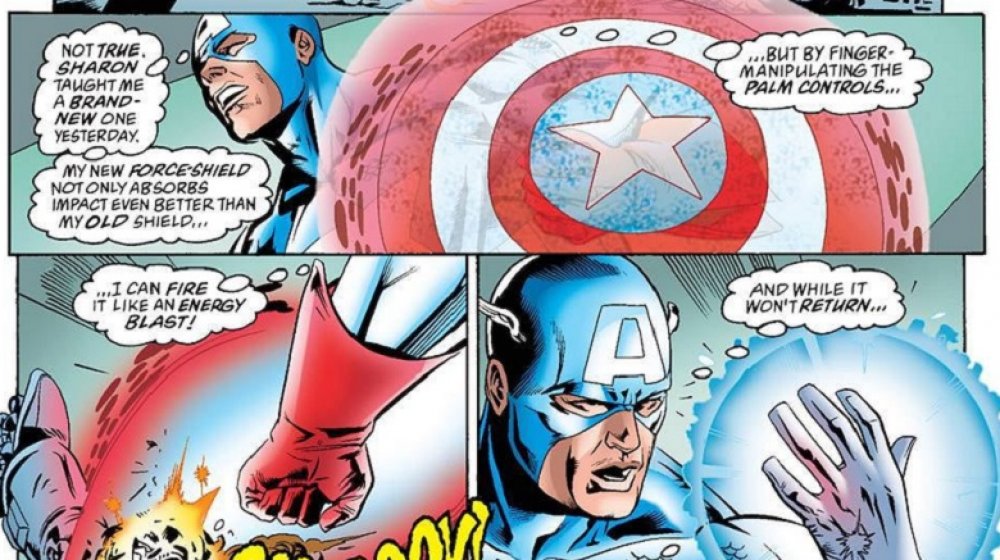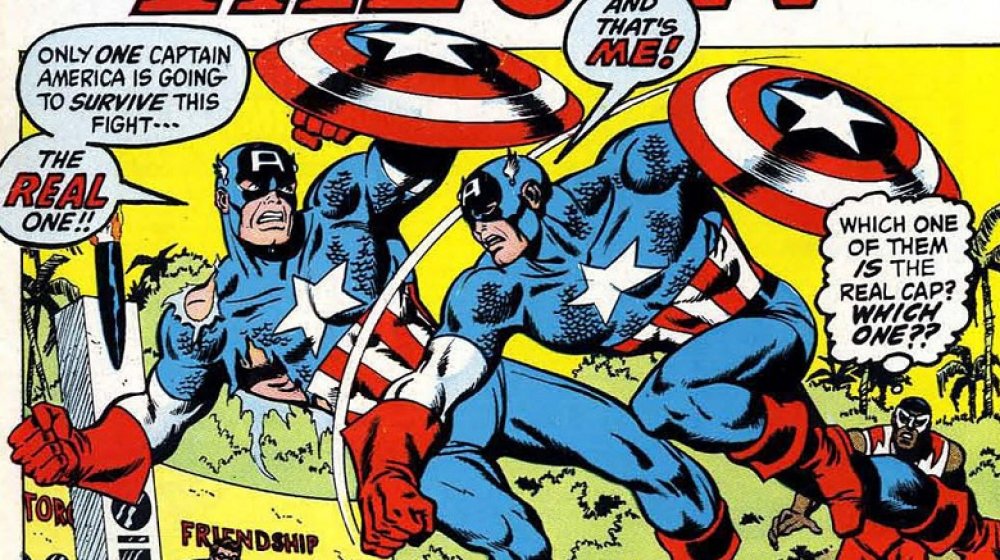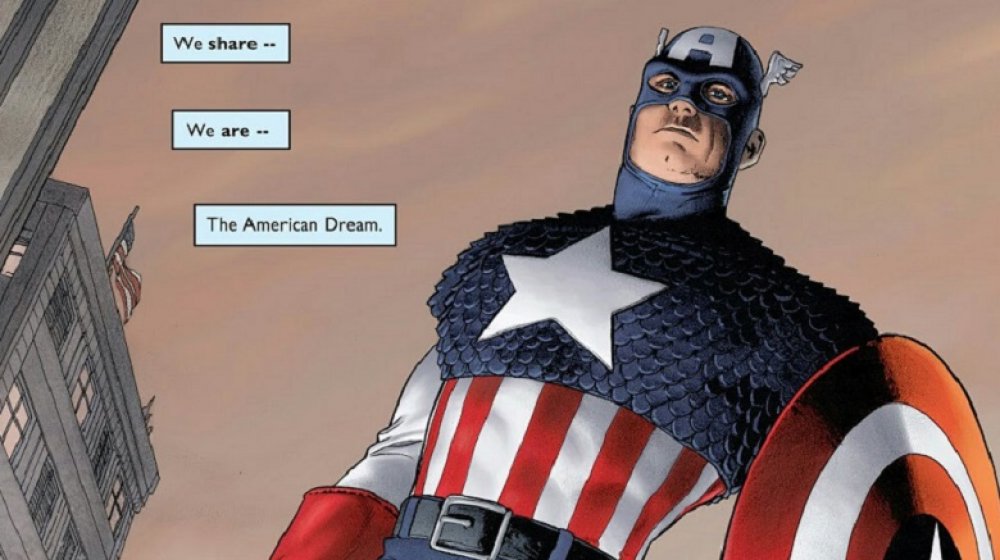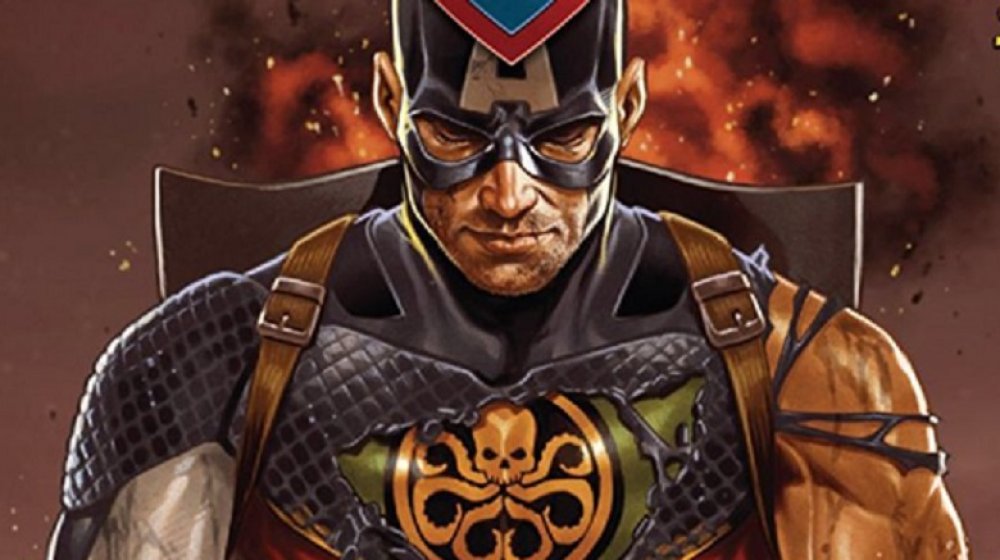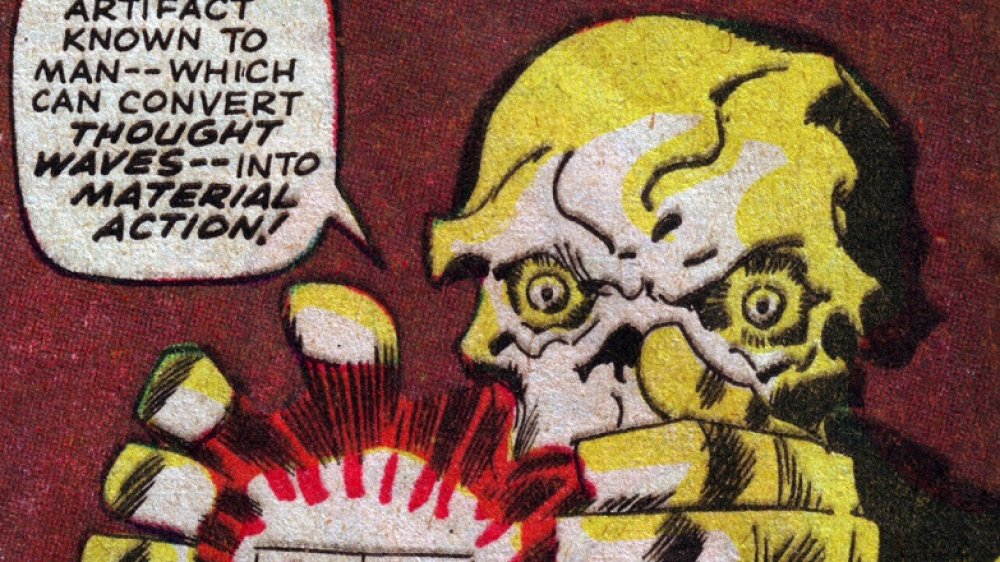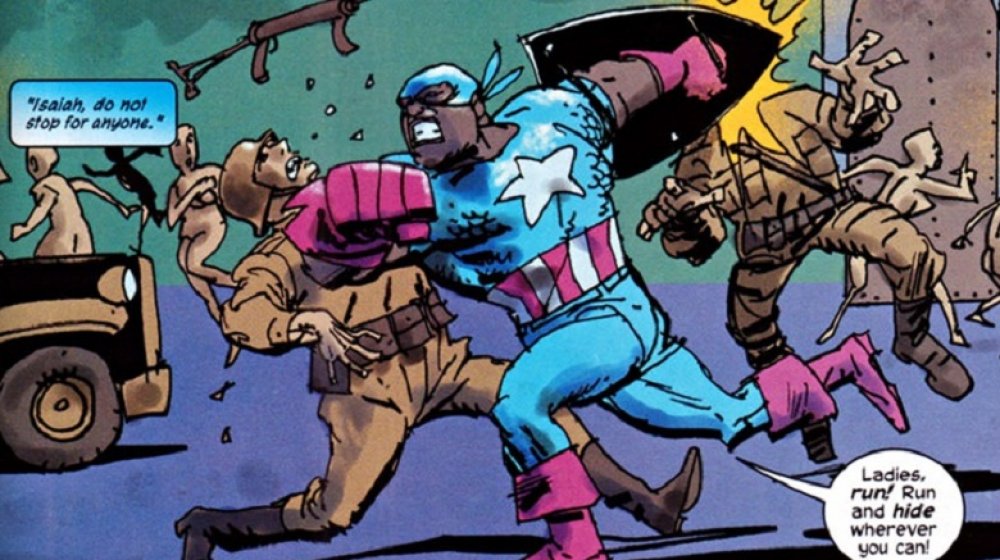Things About Captain America That Didn't Make It Into The MCU
Captain America was created in 1941 by Jack Kirby and Joe Simon. Since his revival in the Marvel Comics Universe in 1963, he's been one of its cornerstones, both as an Avenger and in his various solo titles. When Cap was adapted for the Marvel Cinematic Universe, there was a lot of story to choose from. To the credit of the MCU's writers and directors, they brought in a lot of important components and storylines from Cap's mythos. There was the shield, his best friend Bucky Barnes, the Howling Commandos, Peggy and Sharon Carter, the Red Skull, Batroc the Leaper, Crossbones, Zemo, the Falcon, HYDRA, Arnim Zola, and more.
The MCU also adapted two of the biggest recent Cap storylines. Captain America: The Winter Soldier revealed that Bucky didn't die in World War II. He was captured, brainwashed, and turned into a Soviet assassin. When he wasn't activated, he was kept in suspended animation. Captain America: Civil War found a bitter Zemo masterminding a scheme to get Cap and Iron Man to fight over the Winter Soldier and the very nature of superheroics.
However, Captain America had a lot of other adventures in the comics that haven't surfaced in the films, and it's doubtful that they ever will. Some of them were absurd, some of them were a result of years of serialized storytelling, and many were a result of trying to flesh out the character of Steve Rogers. Here's a look at some of the most notable elements left behind in the comics.
Steve Rogers' day jobs
In the MCU, we can only assume that Cap got paid by either the Avengers or SHIELD to do his shield-slinging. There wasn't much difference between Cap and Steve Rogers, the man. In the comics, there have been attempts to use Cap's secret identity to give him a second career.
A commissioner asked Cap to go undercover as a police officer to root out the mystery of disappearances in Harlem. Steve Rogers had a hard-nosed sergeant named Muldoon who gave him grief. Skirting the line between sympathy for protesters but not too much, a group based on the Black Panthers was revealed to be led by the Red Skull. Later, Muldoon was shown to be the mastermind behind a crime wave, as a reaction to "soft" cops like Rogers who took a community approach. Cap quit the force after busting him.
Years later, after his girlfriend Sharon Carter appeared to die, Cap rearranged his life and became a commercial artist. Drawing was a lifelong passion of his, but this was the first time he tried to establish a civilian identity away from the Avengers and SHIELD. He mostly worked in advertising until he saw kids reading comics and it occurred to him that he could draw them. He went to Marvel Comics, met with Mike Carlin (the actual editor of Cap at that time), and was given the job... of drawing the Captain America series. Talk about life imitating art.
The Invaders
In the MCU, the Avengers were Cap's one and only superteam. He did hang out with the Howling Commandos in World War II, but that was just the nickname of an infantry unit. In the comics, Cap formed a team with the Sub-Mariner and the (original) Human Torch to save British Prime Minister Winston Churchill from the Nazi villain Master Man. When they decided to stay together, Churchill suggested the name "The Invaders" as they helped the Allies invade Europe. They were actually first introduced as a team in a time-traveling issue of The Avengers, where their surprise opponents were the greatest superheroes of World War II.
Over time, the team added Bucky and the Torch's flame-powered ward Toro. The mongoose-blood powered speedster the Whizzer and his wife, Miss America, also became full members. This lineup of the team mimicked the post-WWII team the All-Winners Squad. The team also included British heroes like Union Jack and his sister, Spitfire, who got her powers when the Human Torch gave her a blood transfusion. There were a couple of dozen more active superheroes during World War II, so if Marvel ever decided to do another movie set during the war, they'd have no shortage of characters to choose from.
Nomad: Man without a country!
After the events of Captain America: Civil War, Cap gave up his uniform and SHIELD and went underground. In the comics, Steve Rogers has quit being Captain America several times.
The first and most famous instance came when Cap went up against an evil organization called the Secret Empire that used a disinformation campaign to discredit him. Cap went undercover (with the imaginative alias of "Roger Stevens") in an effort to track down their leader, and the trail led to Washington. The leader of the Secret Empire, #1, emerged from a flying saucer before Cap defeated him.
To Cap's surprise, #1 ran into the White House. While he wasn't mentioned by name, #1 was President Richard Nixon, as writer Steve Englehart himself confirmed. Nixon killed himself before Cap could apprehend him and a disillusioned Cap retired, to the delight of Sharon Carter and no one else.
Hawkeye put on a disguise and a fake Thor accent in an effort to get Cap to remember how much he liked being an adventurer. When Steve told him he wouldn't be Captain America anymore, Hawkeye gave him some advice: adopt a new identity.
Cap used his design skills and became Nomad, the Man without a Country. In a decision that would infuriate Edna Mode, he gave himself a cape. Naturally, he tripped over it on his first mission. Steve became Cap again when the Red Skull killed a kid who tried to take Cap's place.
Kid Cap
In the MCU, Cap has been lucky enough to be spared the indignity of a common rite of passage for long-running superheroes: being turned into something else. In the comics, Cap has had no such luck. One time, Cap got a phone call from his ex-girlfriend Bernie Rosenthal telling him that her younger sister had gone missing. He realized that members of his nationwide teen informant network had befallen the same fate. Trying to find a way to go undercover, he asked Sersi to turn him into a 15-year-old version of himself — but when he was de-aged, he lost the super-soldier serum infusion that made him Captain America in the first place.
Cap's one to normally have a well-developed plan. This was not one of those occasions. Powerless and shieldless, he wandered over to Port Authority and blundered his way into his goal: a "camp" for kids that was a nihilistic death cult. They were pro-drugs, pro-porn, anti-parents, anti-cops, and anti-government. They even whipped up the kids to set a far-right Watchdog member on fire as teen Cap watched helplessly.
Of course, Cap didn't think to ask Sersi how long the transformation would last, or if there was a way to reverse it. So he was bullied by his old enemies Scarbo and Mother Night.
The transformation trigger was the 50th time Cap got punched. Just when it seemed like he was about to be beaten to a pulp, he turned back into his normal self, defeated the villains, and told the kids to stay in school and obey their parents.
Capwolf and the Spider King
Being a kid isn't the only indignity Cap has suffered in the comics. Like any good superhero, Cap has also occasionally been turned into a monster.
In an all-star wolf lineup, Captain America was transformed into a werewolf by Nightshade. She was building a werewolf army for a man named Dredmund, and it included Wolfsbane, Feral, and Man-Wolf. Cap got captured and injected with werewolf serum, but the Super-Soldier serum allowed him to retain control of his wolf form.
This enabled him to not only beat up a lot of bad guys, but his natural leadership skills helped convince the werewolves to fight with him and become Cap's own wolfpack. There was a lot of nonsense about Dredmund becoming the Star-Wolf, and Doctor Druid and Cable got involved, but the Man-Wolf (a.k.a. John Jameson, Jonah's son) turned things around when he injected Nightshade with her own serum. That motivated her to develop an antidote, putting an end to Cap's lycanthropic adventures.
Years later, Cap was kidnapped by the Jackal during the Spider Island storyline and transformed into the monstrous Spider King. A slave of the Spider Queen, the Spider King was disgustingly implanted with thousands of eggs. When those eggs hatched, the resulting spiders would then infect anyone they bit and turn them into a spider-mutate under the Spider Queen's control. He was eventually defeated by Venom, who took him to a facility for a cure. Cap then helped lead the resistance against the arachnid menace.
The Energy Shield
One of the most memorable moments in Avengers: Infinity War came when Black Panther issued the command "Get this man a shield!" Cap was given a new shield by T'Challa in order to fight Thanos' forces, since he had given up his original. In the comics, he's used a few metallic replacements for his original shield, but his energy shield was far more formidable.
Once when Cap was fighting HYDRA, his seemingly indestructible shield was affected by a Vibranium virus and torn to pieces. He used his original, triangular shield for a while, but that was also destroyed. Sharon Carter, who'd returned from the dead not long before, gave Cap an energy shield he'd wielded briefly before.
While nothing could ever replace the strong, light, and highly-balanced shield that was practically an extension of his own body, the energy shield was pretty handy. Made from cooled plasma energy, it could morph into various shapes. Cap used it as a sword, a staff, a lasso, and of course as a shield. This is what Cap took into battle when the Avengers faced Ultron in Sokovia.
Years later, after Steve Rogers handed over the Captain America mantle to Bucky Barnes, he used a different energy shield. This one was comprised of Zero-Point Energy, which allowed him to throw it and use it to bounce off of his opponents before it dissipated. A new one would then be automatically generated.
Nothing beats the original, though: a mix of steel, Vibranium, and a mysterious X factor similar to Adamantium.
Cap of the 1950s
Time is a funny thing in the comics. In the MCU, Cap was on ice for over 60 years. In the comics, he was revived in 1963, less than 20 years after he went into suspended animation. However, Captain America continued to appear in comics until the late 1940s, and again in the 1950s. His '40s appearances were retconned as the government briefly assigning men like the Patriot and Spirit of '76 the job. However, the '50s Cap was a different matter.
That Cap mostly fought super-communists. Twenty years later, he was retconned as a man obsessed with Captain America who managed to come across the formula for the super-soldier serum. As the U.S. was fighting in the Korean War, the government needed a new symbol, and he volunteered. He even had plastic surgery to make him look and sound like Steve Rogers.
Shelved because the war ended, he stole the serum and used it on himself and a student who looked like Bucky. It made them super strong, and they became Cap and Bucky. However, without the steadying influence of Vita-Rays, the serum ate away at their minds. They were captured and put in suspended animation.
A disgruntled government functionary freed them and told them about the "new" Captain America. Spouting racist epithets, they tracked down Cap and the Falcon, who narrowly defeated them. Fifties Cap would return as the leader of a white supremacist cult.
9/11
The aftermath of the 9/11 attacks was a grim and confusing time for the U.S., and the same was true for Captain America. In the MCU, however, Cap didn't get revived until long after that tragedy.
Rebooting as part of the Marvel Knights brand, the first issue of a newly relaunched Captain America series found Cap sifting through the wreckage of 9/11. Nick Fury tasked him to track down the culprits, but Cap preferred staying a part of the rescue operations.
That changed when terrorists took the American town of Centerville hostage. Cap infiltrated it and attacked the mastermind, a terrorist named Al-Tariq. The writer, John Ney Rieber, tried to keep things as balanced as possible. For example, Cap saved an Arab-American youth earlier in the issue from a gang that was threatening to kill him. One of the members of the gang lost someone in 9/11.
Similarly, the children that Al-Tariq had strapped bombs to were all victims of unexploded landmines. When they realized they were being used, they helped Cap defuse the bombs attached to the citizens of Centerville, all trapped together in a church.
Cap grew suspicious when he saw that Al-Tariq was wearing a piece of technology called a CATtag that was ostensibly used to monitor vital signs. Fury and the government acted deliberately shifty with him. He eventually learned that a man affected by the Cold War was planning to kill every American wearing one. These issues showed the limitations of Captain America as a character in light of real-world concerns.
Hail HYDRA!
In the MCU, Captain America has managed to avoid mind control, clones, and other devices to create an evil Cap. In the comics, there was an audacious storyline that imagined: what if Captain America had been a bad guy all along?
SHIELD had the bright idea of using a sentient Cosmic Cube named Kobik to create a prison disguised as a town for supervillains. Kobik kept them all pacified until she didn't, when it was revealed that the Red Skull had corrupted her. The reality-altering Kobik recreated Cap as always having been loyal to HYDRA as a deep-cover agent.
The problem with making Cap a secretly evil agent loyal to HYDRA is that he's probably going to do too good a job at it. Sure enough, he killed the Red Skull when he wasn't looking and took over HYDRA. Like any good megalomaniac, he was trying to conquer the world. He had most of the pieces of Kobik's shattered body, so he was in a position to do it.
Unbeknownst to him, the real Cap was wandering around inside of Kobik's mind. Kobik regretted her actions, but she was helpless until her true self was recreated when all the fragments of the Cosmic Cube were reformed. Bucky Barnes helped bring out the real Cap, who defeated his doppelgänger. Steve quit being Captain America for a while after that, picking up the energy shield yet again.
Never-Ending Red Skull
In the MCU, Cap and his archenemy the Red Skull fought just a couple of times in World War II. In the comics, the Red Skull clashed with Captain America on many occasions, until they had a final showdown near the end of the war. Cap barely escaped an explosion, but the Skull was trapped in a building and exposed to gases that put him in suspended animation.
After the Skull was revived from suspended animation, he proved to be a lethal nuisance for years. He hoodwinked the Cosmic Cube from AIM and almost destroyed Cap with it. He teamed up with Adolf Hitler, in his Hate-Monger guise, then later trapped him in the Cube. He activated Sleeper robots to plague Cap.
Later, he became head of a commission that forced Cap to give up his identity, funding both anarchist and fascist organizations. Along the way, he got his head handed to him by Magneto, who hated Nazis. He was also defeated by the Kingpin, who hated Nazis who infringed on his drug trade. He became the Secretary of State (as "Dell Rusk"), tried using biological weapons, and eventually was also defeated by the Black Panther.
The Skull briefly gained cosmic powers before being defeated by Korvac. He later stole Professor X's brain to get his powers and kill all the mutants. The Skull also had Cap assassinated after Civil War in a play to take over his body.
The Truth and Isaiah Bradley
In the MCU, Steve Rogers was the one and only American to receive the genuine super-soldier serum. In the comics, however, there have been many men who received a variation of the serum as the government tried to develop an army of super-soldiers. One of these men was Isaiah Bradley, who was drafted into World War II shortly after getting married and quickly conscripted into an experiment along with 300 other Black men in an effort to recreate the serum.
In a gruesome and unethical series of experiments, the survivors became covert soldiers for black-ops missions. Bradley, the only survivor, was sent on a suicide mission to kill a Nazi scientist trying to develop a super-soldier formula. Bradley was successful and also destroyed a Nazi death camp, but he was ultimately captured.
He escaped thanks to some freedom fighters, but he was immediately court-martialed and imprisoned upon his return to the U.S. because he had stolen a Captain America outfit and shield. He was in prison for nearly two decades, and his mind started to decay thanks to the faulty serum (and no Vita-Rays).
Bradley quietly received visitors who were there to pay their respects to the Black Captain America, whose name they had only heard in whispers. His son Josiah and his grandson Eli both spent time as heroes, with Eli forming the Young Avengers.
Steve Rogers, once he learned of Bradley's existence, also stopped by his home to pay his respects.
